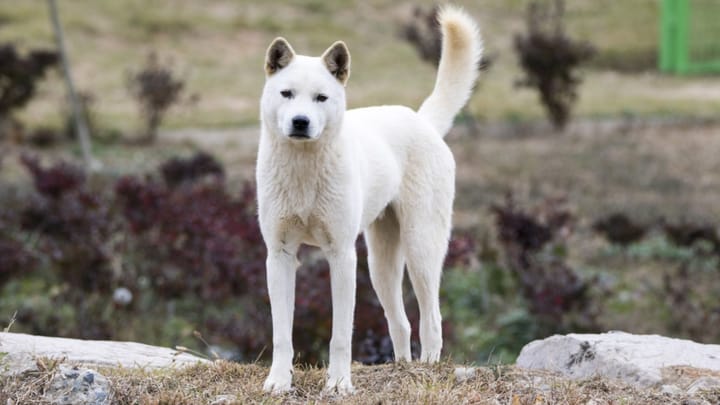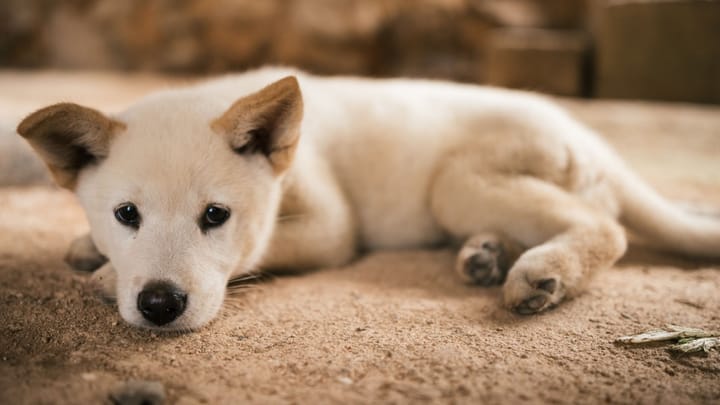Korea Jindo Dog
Other names : Korean Jindo, Jindo, Chindo, Jindo Gae, JindoGae


Korea Natural Treasure #53, as she’s sometimes known, is a smart, sensitive, and loyal spitz-type dog originating from the South Korean island of Jindo. There she dwelt, unfettered, for many centuries, hunting alongside her masters; today, she has become a small-scale international hit – helped, no doubt, by a starring role marching in the opening ceremony for the Seoul Olympics in 1988. Bright, adorable, and self-reliant, these angular doggos love exercise and games but hate water. Tough when you live on an island, eh?
|
Life expectancy |
The Korea Jindo Dog has a life expectancy of between 11 and 13 years |
|
Temperament |
|
|
Size |
Medium
|
|
Adult size |
Female
Between 18 and 20 in
Male
Between 20 and 22 in
|
|
Adult weight |
Female
Between 33 and 42 lb
Male
Between 40 and 51 lb
|
|
Coat colour
Red fawn, white, black, black and tan, wolf grey, or brindle. |
Black White Red |
|
Type of coat
Double: soft, dense undercoat and stiff outer coat. |
Long |
|
Eye colour
Dark brown. |
Brown
|
It’s illegal to export Korea Jindo Dogs out of Korea, but a few have been gathered in the US and in France.
More details about the Korea Jindo Dog
Korea Jindo Dog: Origins and history
The Jindo evolved into a great hunter and companion over thousands of years on her island, Jindo, off the southwest coast of Korea. She achieved ‘national treasure’ status in 1962 and wider fame after the news story about the Jindo who ran 180 miles back to her owner in 1993.
Physical characteristics of the Korea Jindo Dog
Looking somewhat like a Korean take on the Japanese Shibu-Inu, the Korea Jindo Dog is a tidy, well-proportioned cutie who will draw the attention of admirers with her perky equilaterally triangular ear flaps. A curved, sickle shaped brush of a tail at the other end keeps you drawn-in. Wolfish, only prettier, the Korea Jindo Dog is muscular under that fur. The fur can be one or two of several colours, and she’s particularly irresistible when her ears are a different colour to the rest. The female is more angular about the head and slighter than the male; but Jindo-fanciers also distinguish between different body types, the stocky Tonggo and the slender but more pronounced Hudu. Hudu? She do.
FCI classification of the Korea Jindo Dog
-
Group 5 - Spitz and primitive types
-
Section 5 : Asian Spitz and related breeds
Korea Jindo Dog: Characteristics
Korea Jindo Dog: Behaviour
Training a Korea Jindo Dog
She’s clever enough to learn, but her free-spiritedness means that perseverance is necessary. With a skilled master, a beautiful partnership can be achieved.
Korea Jindo Dog: Lifestyle
Breed compatibility Korea Jindo Dog
Korea Jindo Dog: Purchase price
We do not have enough data to set an average price. Looking after a dog of this size typically costs between £60 to £90 a month, including food, medical/insurance, and incidental expenses.
Korea Jindo Dog: Grooming
This dog likes to keep herself clean, but if you don’t help her out she’s likely to become unhappy: weekly brushing should satisfy her.
Korea Jindo Dog: Health
This breed is generally very healthy with few genetic illnesses and an average life expectancy of 12 years.
This is usually a fit and healthy dog that will lead a long and decent existence.
She is moderately tolerant of hot weather, but will require a cool shelter in a heat wave.
She can easily live outside because her double coat will protect her from cold weather.
She is neither a big eater nor a big grower.




